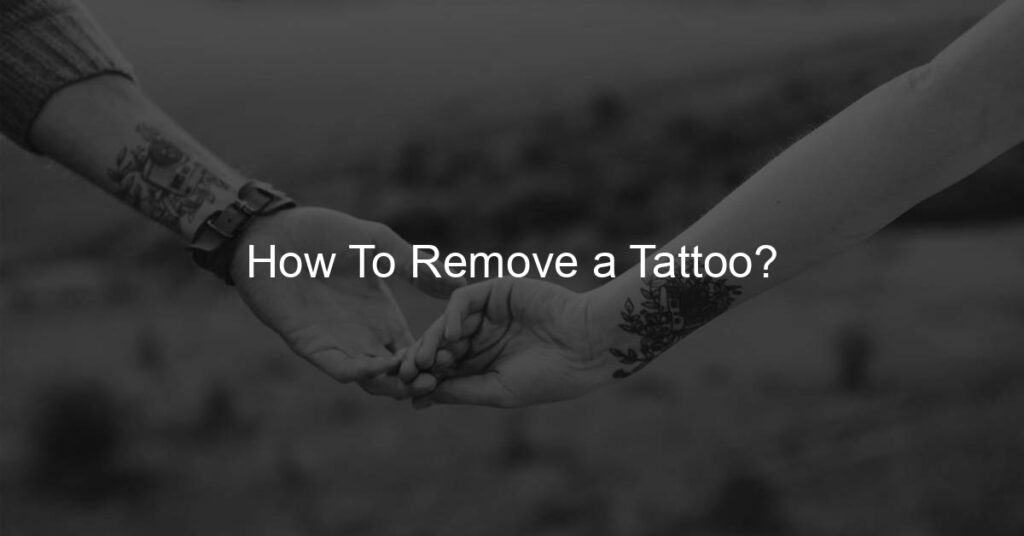Tattoo removal is a process many people consider when they no longer want the permanent ink on their bodies. Whether it’s due to a change in personal tastes, career demands, or simply a desire for a fresh start, removing a tattoo can be an important decision. With advances in technology and a better understanding of how tattoos interact with our skin, various techniques have emerged, offering new ways to get rid of unwanted tattoos.
It’s important to understand that tattoos embed the ink deep within the layers of the skin, with professional tattoos going deeper than amateur ones. This makes removal more challenging but not impossible. A variety of methods are employed, each with its own costs, potential risks, and aftercare requirements. Understanding the intricacies of tattoo removal is necessary to make informed decisions on which method to choose and how to navigate the process.
Key Takeaways
- Tattoo removal techniques have evolved, offering different ways to erase unwanted ink.
- Professional tattoos go deeper into the skin, making removal more challenging.
- Costs, risks, and aftercare should be carefully considered when choosing a removal method.
Understanding Tattoo Removal
I have come to realize that tattoo removal is a popular but often misunderstood process. In order to achieve the best results, it’s important to have a clear understanding of how tattoo removal works and which factors can influence the outcome.
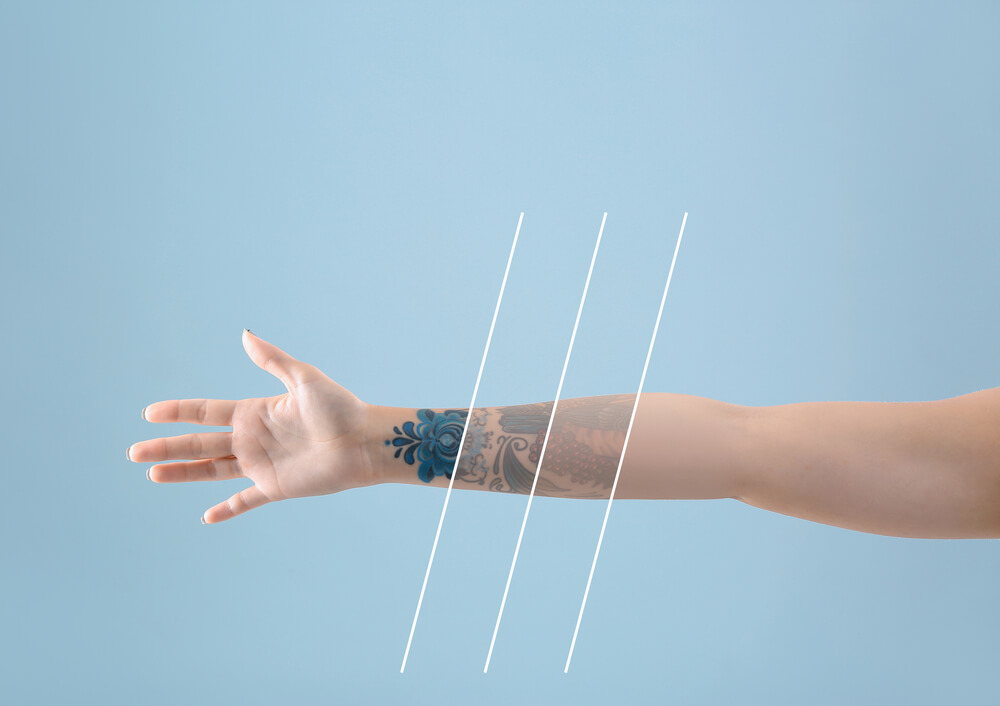
Tattoo removal is commonly done by dermatologists or other qualified providers who use specialized laser technology to break down the tattoo ink particles beneath the skin. The process can be tailored according to the specific type of ink and color used in the tattoo, as well as the individual skin type of the candidate.
During my research, I found that while tattoo removal is generally a safe and effective procedure, some risks and side effects can occur, including skin irritation, scarring, or changes in skin color. These side effects can be minimized by following the advice of a knowledgeable provider and adhering to proper aftercare instructions.
It’s important to remember that not all tattoos are easily removed, and multiple sessions may be required for the best results. Certain factors can affect the success of the tattoo removal process, such as:
- Age of the tattoo: Older tattoos are often more challenging to remove than newer ones, as the ink particles have had more time to settle into the skin.
- Ink quality and colors: Some ink colors (like greens and blues) are more difficult to remove, and cheap or low-quality ink might make the process more challenging.
- Tattoo size and placement: Larger tattoos or those located on areas with thicker skin might require more sessions or take longer to remove.
In conclusion, understanding tattoo removal is crucial for setting realistic expectations and achieving the desired outcome. By being aware of how the process works and the factors that can impact its success, I am better equipped to make informed decisions when it comes to removing a tattoo.
Layers of Skin and Tattoos
When it comes to tattoos, understanding the layers of skin is crucial. Our skin primarily consists of three layers: the epidermis, dermis, and hypodermis. The epidermis is the outermost layer, the dermis lies beneath it, and the hypodermis is the deepest layer.
As I apply a tattoo, I penetrate the needle past the epidermis and inject the ink into the dermis layer. This method ensures the tattoo’s longevity because the dermis is more stable as compared to the ever-shedding epidermis. Tattoo ink is made from various components, including pigments and carrier solutions, which allow the ink to spread evenly under the skin.
During the tattoo removal process, I target the ink particles within the dermis without damaging the upper epidermis. By doing so, I can effectively remove the tattoo while preserving the integrity of the skin. Several techniques are available for removing tattoos, including laser removal, dermabrasion, and surgical excision.
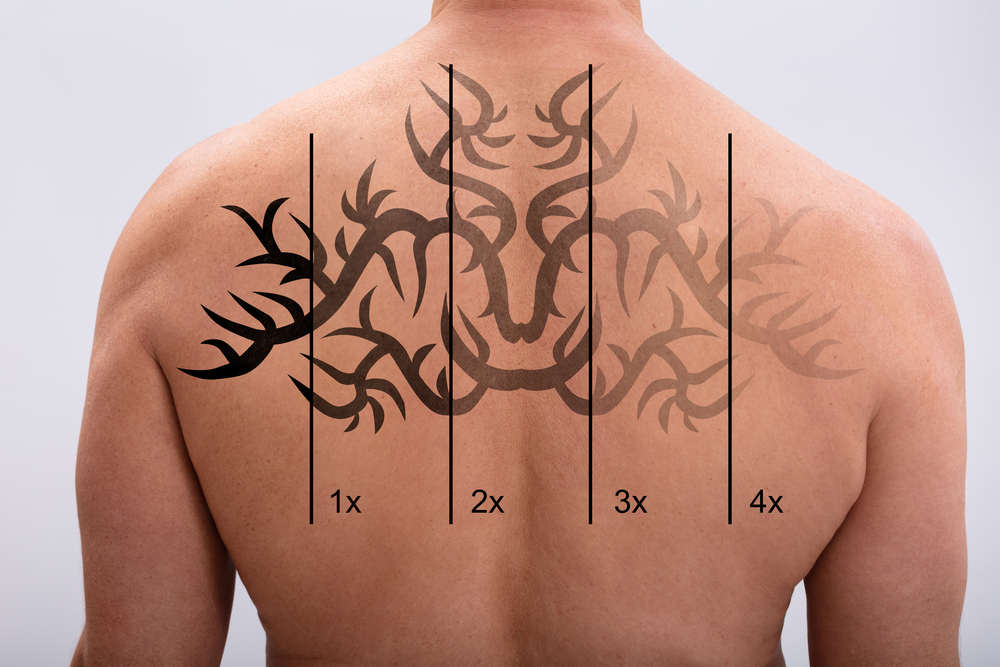
Methods of Tattoo Removal
Laser Tattoo Removal
I’ve found that laser tattoo removal is one of the most popular and effective methods for removing tattoos. The procedure typically involves using a high-intensity light beam from a Q-switched laser or the Q-switched Nd laser. These lasers work by breaking up the ink particles in the skin, which the body then removes through natural processes. Laser therapy does require multiple sessions, depending on the size and colors of the tattoo.
Dermabrasion
Another method I’ve come across is dermabrasion, which involves sanding the skin to remove the outer layers and reach the tattoo ink. The process can be painful and may require anesthesia or numbing creams beforehand. After dermabrasion, the skin may be raw and sensitive, so proper care is essential for successful healing.
Chemical Peels
In my research, I’ve discovered that chemical peels can also be used to remove tattoos. Chemical peels involve applying an acidic solution, like trichloroacetic acid, to the skin. This causes the top layers to shed and eventually peel away, taking some of the tattoo ink with it. Just like with laser and dermabrasion, multiple sessions are often needed for the best results.
Surgical Tattoo Removal
A more invasive option I’ve learned about is surgical tattoo removal, which involves cutting out the tattoo using a scalpel. The process is done under local or general anesthesia, depending on the tattoo’s size and location. While this method is quick, it does leave a scar and may not be suitable for large or intricate tattoos.
Tattoo Removal Creams
An alternative I’ve found is using tattoo removal creams, which claim to break down and remove tattoo ink from your skin. However, their effectiveness varies greatly, and some experts are skeptical about their ability to deliver significant results. It’s also worth noting that these creams may contain harmful chemicals that could irritate the skin.
DIY Tattoo Removal Methods
I’ve come across various DIY tattoo removal methods that people try at home. Some popular options include lemon juice, honey, paederia tomentosa, vitamin E, and aloe vera. While natural remedies might be tempting, it’s important to remember that their effectiveness is questionable. Additionally, using these methods improperly can potentially lead to skin damage and infections. It’s always best to consult with a professional before attempting any DIY tattoo removal techniques.
Cost of Tattoo Removal
When it comes to removing a tattoo, one of the primary factors to consider is the cost. From my experience, the cost of tattoo removal can vary greatly depending on several factors, such as the size, colors, and location of the tattoo, as well as the chosen removal method.
I believe the most common method of tattoo removal is laser removal, which is often performed at a medical spa. In general, the cost of laser tattoo removal ranges from $200 to $500 per session. It’s worth noting that multiple sessions are usually required to fully remove a tattoo. Hence, the total cost can add up quickly, potentially reaching thousands of dollars for larger or more intricate tattoos.
Apart from laser removal, there are other methods that can be less expensive, such as tattoo removal creams and dermabrasion. However, these methods may not be as effective and can come with additional risks. Tattoo removal creams can cost anywhere from $50 to $200 per bottle, while dermabrasion can cost between $100 and $500 per session, depending on the size and depth of the tattoo.
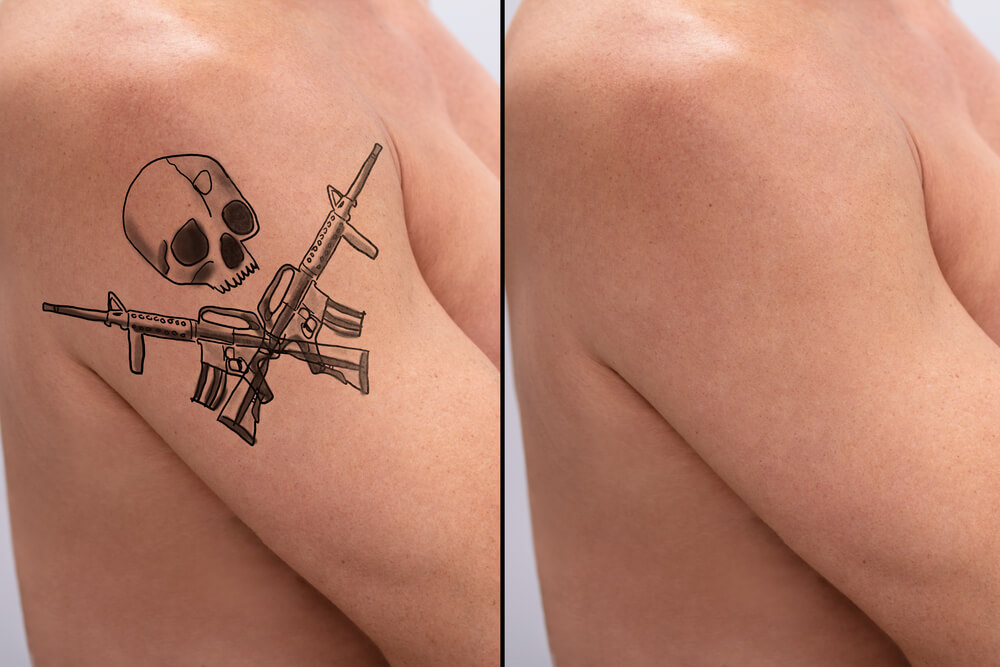
Keep in mind that some medical spas may offer discounts or payment plans for tattoo removal services. Additionally, it’s crucial to factor in any required aftercare products, follow-up appointments, and potential downtime that could be necessary, as these can also contribute to the overall cost.
In conclusion, it’s essential to thoroughly research and compare different tattoo removal methods and providers to make an informed decision. Understanding the long-term implications of your choice and carefully considering the costs can help you achieve the best possible results for your tattoo removal journey.
Potential Risks and Side Effects
I would like to discuss some of the potential risks and side effects associated with tattoo removal. It is important to be aware of these before undergoing any tattoo removal procedure.
Firstly, pain is a common side effect during the removal process. Many people find the tattoo removal procedure to be more uncomfortable than getting the actual tattoo. The level of pain experienced can vary from person to person and can be managed through the use of numbing creams or other pain-relief measures.
Another potential side effect is scarring. While tattoo removal techniques have improved over the years, there is still a risk of scarring, particularly if an experienced professional does not perform the procedure. In some cases, the scarring may be permanent or require further treatment to address.
Infections can also occur after a tattoo removal treatment. This risk can be minimized by following proper aftercare instructions provided by the professional performing the procedure. However, it is essential to be vigilant for signs of infection such as redness, swelling, and discharge, as these can lead to complications if left untreated.
Swelling and discomfort are also common side effects after a tattoo removal session. These usually subside within a few days to a week. Applying ice packs and taking over-the-counter anti-inflammatory medications can help reduce these symptoms.
Discoloration is another possible side effect of tattoo removal. In some cases, this can be a temporary side effect, with the skin regaining its normal pigmentation over time. However, in some instances, permanent skin discoloration may occur. This generally depends on factors such as the type of ink used, the depth of the tattoo, and the removal method employed.
Allergic reactions might also happen during a tattoo removal procedure. This is rare, but if you have experienced an allergic reaction when getting the tattoo, you may be at a higher risk. Inform your tattoo removal professional about any allergies you have so they can take the necessary precautions.
Lastly, blisters are a common side effect of laser tattoo removal. These typically heal on their own within a week. It is important to avoid picking or popping the blisters, as this can increase the risk of infection and scarring.
Aftercare and Healing
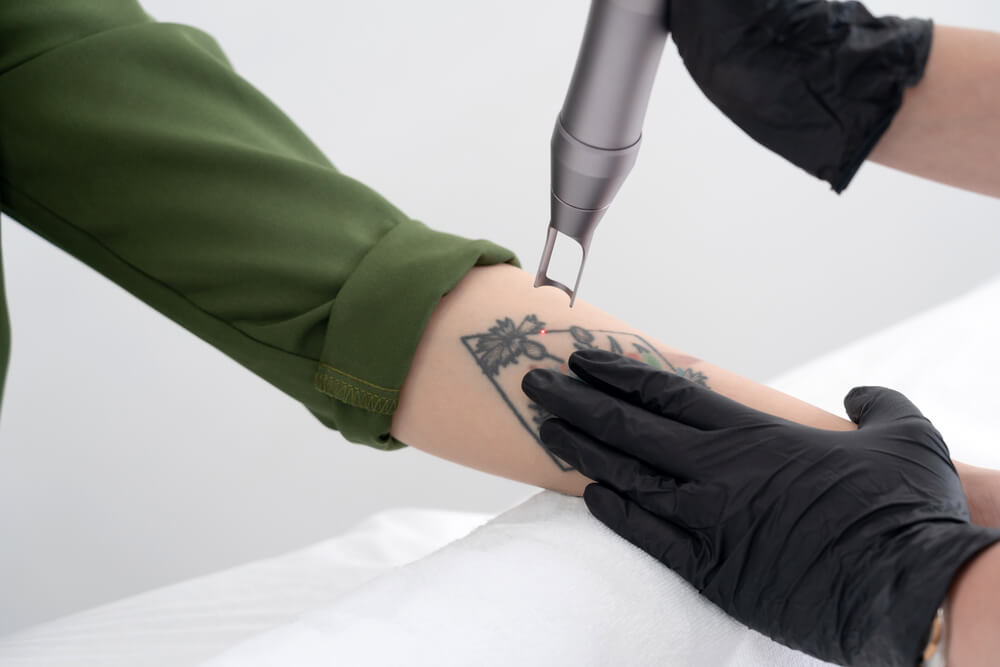
I know that proper aftercare is essential for tattoo removal healing. After the removal treatment, I would follow the aftercare instructions provided by the professional to ensure optimal results and prevent any complications.
Initially, I would keep the treated area clean and dry by gently washing it with mild soap and water. It’s crucial to avoid soaking the area in water during the first few days of healing. Applying a thin layer of antibiotic ointment can help prevent infections. Also, covering the area with a non-stick bandage would protect it from dirt and bacteria.
Reducing sun exposure is important after a tattoo removal session. I would avoid direct sunlight on the treated area, and when it’s necessary to be outdoors, I’d wear protective clothing and apply a broad-spectrum sunscreen with an SPF of 50 or higher on the exposed skin. This helps prevent skin damage and discoloration caused by ultraviolet (UV) radiation.
During the healing process, I expect the area to peel, itch, and develop scabs. It’s essential not to scratch, pick, or peel these as doing so may cause scarring or infection. Instead, I’d use a gentle moisturizer to help alleviate itching and keep the skin hydrated.
Throughout the healing process, I would closely monitor the treated area for any signs of infection, such as increased redness, swelling, or discharge. If I notice any of these signs, I would reach out to the tattoo removal professional for further guidance and, if necessary, medical assistance.
Other Considerations
When it comes to tattoo removal, there are several factors I need to consider before beginning the process. Taking into account the unique traits of my tattoo and skin can greatly impact the success and comfort of the removal process.
Firstly, older tattoos are generally easier to remove than newer ones. This is because the ink in my older tattoo has likely faded over time, making it easier for the laser to break it down. Conversely, removing my newer tattoo may require additional sessions to achieve the desired results.
It’s also crucial for me to consider my skin type when deciding on a tattoo removal method. If I have darker skin, the removal process can be more complicated, as the laser may not be able to differentiate between the pigment in my skin and the ink. Having sensitive skin can make the removal process more uncomfortable, so being prepared for how my skin may react is essential.
In addition, the types of inks and pigments used in my tattoo can impact how difficult it is to remove. Some colors, such as black and blue, are easier to break down with laser treatment, while others, like green, yellow, and white, maybe more stubborn. Considering the colors in my tattoo before choosing a removal method can help set realistic expectations.
Lastly, understanding that individual skin types and tattoo characteristics can vary greatly means that no two tattoo removal experiences will be identical. Staying informed and consulting with an experienced professional can help ensure the best possible outcome for my tattoo removal journey.
Conclusion
I believe it’s essential for anyone considering tattoo removal to consult with a healthcare provider or a licensed dermatologist. They can provide expert guidance and recommend the most appropriate removal method for each case. As I explored tattoo removal methods, I learned the importance of numbing creams, which can help reduce pain during the treatment.
During the tattoo removal process, it’s crucial to maintain self-confidence and remain aware of the reasons behind the decision.
I understand that some people may have concerns about how the removal will affect their skin or overall health. However, by working with a professional, potential complications can be minimized, and patients can achieve the desired results. In some cases, certain methods might even help leach out harmful chemicals that could be present in tattoo ink.
In my research, I discovered that there are multiple tattoo removal options available that cater to people’s individual needs and preferences. By staying informed and following the advice of qualified professionals, I am confident in my ability to navigate the tattoo removal journey with the best possible outcome.
Frequently Asked Questions
What are the most effective tattoo removal methods?
In my experience, the most effective tattoo removal method is laser removal. It involves targeting the tattooed area with specific wavelengths of light energy, breaking down the ink pigments into smaller particles. These particles are then absorbed and flushed out by the body’s immune system. Other notable methods include dermabrasion, excision, and chemical peels.
Are there any DIY methods for tattoo removal?
While some DIY methods exist, I wouldn’t recommend them due to potential risks and lower effectiveness. These methods include using salt scrubs, chemical peels, and creams. It’s always best to consult a professional for safe and effective tattoo removal.
What are the side effects of laser tattoo removal?
Laser tattoo removal can cause some temporary side effects, including redness, swelling, and blistering. Scarring and discoloration may also occur in rare cases. To minimize any complications, it’s crucial to follow the aftercare instructions provided by the professional performing the treatment.
How safe is the tattoo removal process?
When performed by a licensed and experienced professional, tattoo removal is relatively safe. Risks and complications can be minimized by properly following aftercare instructions and attending scheduled sessions. Always consult with a professional to discuss your specific tattoo and any concerns you may have.
How long does it take to remove a tattoo completely?
The time it takes to remove a tattoo depends on various factors such as the size, color, and age of the tattoo, as well as your skin type. Generally, laser tattoo removal requires multiple sessions, with six to eight weeks between each treatment to allow the skin to heal. In total, it may take anywhere between six months to over a year to fully remove a tattoo.
What factors influence the success of tattoo removal?
Several factors influence the success of tattoo removal, including ink color, tattoo age, and the individual’s skin type. Black and darker-colored inks absorb the laser energy better, making them easier to remove. Older tattoos also tend to fade more quickly than newer ones. The individual’s skin type plays a role, too; those with lighter skin tones may experience better results as the laser can selectively target the ink more effectively.

